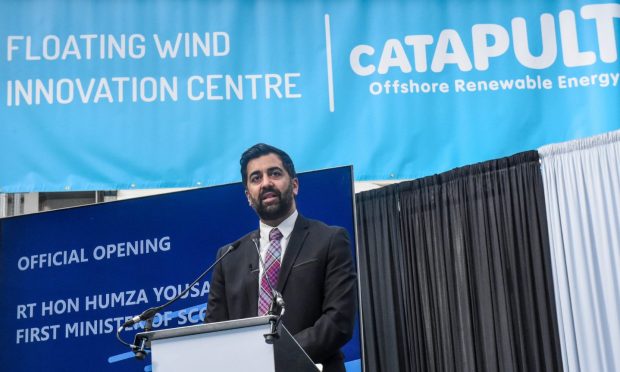First Minister Humza Yousaf dangled the carrot of cheaper energy bills for hard-pressed households as he officially opened the new Floating Wind Innovation Centre (Flowic) in Aberdeen.
He acknowledged there is a lot to do to make sure onshore infrastructure, and in particular the national grid, can handle the energy output of a wave of new windfarms being built in the North Sea.
But he also insisted grid capacity constraints can be tackled by making sure the need for huge investment in this key part of the Scottish and wider UK energy transition is “vocalised”.
Upgrading the grid
The electricity network is not currently up to the task of connecting all the energy that will be generated by new offshore wind projects to homes and businesses across Britain.
A major project is under way – the “Great Grid Upgrade” to make it fit for the future.
According to the National Grid, which builds and maintains the network, the upgrade may create as many as 130,000 jobs and deliver up to £11 billion for the UK economy.
Currently, wind farms – both on and offshore – receive “constraint” payments to cut their output at certain times of the year due to electricity grid congestion or high winds.
Ultimately, households end up paying for this through “network costs”.
Asked if consumers may also end up paying the price for transforming the grid to cope with more wind power, Mr Yousaf said Scots could, by contrast, benefit from lower energy bills “if we are able to capitalise on the opportunity” of more turbines offshore.
Flowic is believed to be the world’s first dedicated innovation centre for floating offshore wind.
The £9 million facility is the result of a partnership between the Offshore Renewable Energy (Ore) Catapult and ETZ Limited, the firm spearheading the development of Aberdeen’s Energy Transition Zone.
Project partners say the new centre, which has been set up with funding from both the Scottish Government and Innovate UK, can help supercharge the development of floating offshore wind technology in the seas around Britain.
Industry has estimated that floating offshore wind has the potential to deliver in excess of £43.bn in UK economic impact by 2050, while also creating more than 29,000 jobs.
‘Tragic and unforgivable’
Mr Yousaf said it would be “tragic and unforgiveable” if Scotland failed to capitalise on the opportunities of offshore wind.
Flowic “embodies the spirit of collaboration” that will drive the industry forward”, he added.
Net-zero ambitions require economic and societal transformation, with sustained investment, both public and private, to achieve them, the first minister said.
He continued: “We know the scale of the change needed.
“Flowic also epitomises the relentless pursuit of science in helping to decarbonise our economy and represents a collective determination to solve the complex challenges posed by our net-zero ambitions.
“We share a common objective to establish Scotland as a first mover in floating wind technology on an industrial scale, and by seizing this advantage we can position Scotland among the world’s leaders in this groundbreaking industry as we maximise the opportunities of our ‘just” transition.”
‘Groundbreaking step forward’
Ore Catapult chief executive Andrew Jamieson said: “This facility represents a groundbreaking step forward in the commercialisation of floating offshore wind – a sector that will be critical to meeting our net-zero targets.
“When you look at the projected global market demand for floating wind technology over the coming years, the opportunity is eye-watering.
“Others are chasing the same prize though, so the time is right to make sure Scottish and UK companies are at the front of that race, and this facility is a key part of helping that happen.”
ETZ chairman and energy industry doyen Sir Ian Wood said Flowic “marks a hugely significant milestone” for the north-east and and its ambition to be a global leader in the commercialisation of floating wind.
Sir Ian added: “Owing to its world-class oil and gas industry, this region has gained an international reputation for pioneering innovative energy solutions over the last 50 years.
“The creation of this groundbreaking centre will help cement that position going forward as we seek to capitalise on the huge opportunities presented by floating offshore wind.”
Offshore wind projects kick-started by the ScotWind leasing round are expected to deliver more than 19 gigawatts of new energy. A separate leasing round, Intog, has created an opportunity for floating wind to contribute to decarbonising North Sea energy production.
Sir Ian said: “A massive 17GW of planned floating wind projects are within 100 nautical miles of Aberdeen.
“This market-leading facility (Flowic) will have an internationally recognised capability to reduce the costs of energy from these developments, supporting the incubation of new products, services and businesses across the energy sector.
“We are already seeing a number of supply chain businesses actively transitioning toward offshore wind, creating jobs as they do so.
“The operation of this centre will provide greater confidence for them to scale and grow.







Conversation